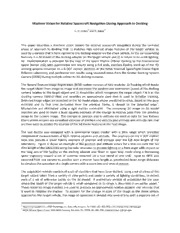
NASA Technical Reports Server (NTRS) 20110023555: Machine Vision for Relative Spacecraft Navigation During Approach to Docking PDF
Preview NASA Technical Reports Server (NTRS) 20110023555: Machine Vision for Relative Spacecraft Navigation During Approach to Docking
Machine Vision for Relative Spacecraft Navigation During Approach to Docking C. H. Chien1 and K. Baker2 This paper describes a machine vision system for relative spacecraft navigation during the terminal phase of approach to docking that: 1) matches high contrast image features of the target vehicle, as seen by a camera that is bore-sighted to the docking adapter on the chase vehicle, to the corresponding features in a 3d model of the docking adapter on the target vehicle and 2) is robust to on-orbit lighting. An implementation is provided for the case of the Space Shuttle Orbiter docking to the International Space Station (ISS) with quantitative test results using a full scale, medium fidelity mock-up of the ISS docking adapter mounted on a 6-DOF motion platform at the NASA Marshall Spaceflight Center Flight Robotics Laboratory and qualitative test results using recorded video from the Orbiter Docking System Camera (ODSC) during multiple orbiter to ISS docking missions. The Natural Feature Image Registration (NFIR) system consists of two modules: 1) Tracking which tracks the target object from image to image and estimates the position and orientation (pose) of the docking camera relative to the target object and 2) Acquisition which recognizes the target object if it is in the docking camera Field-of-View and provides an approximate pose that is used to initialize tracking. Detected image edges are matched to the 3d model edges whose predicted location, based on the pose estimate and its first time derivative from the previous frame, is closest to the detected edge1. Mismatches are eliminated using a rigid motion constraint. The remaining 2d image to 3d model matches are used to make a least squares estimate of the change in relative pose from the previous image to the current image. The changes in position and in attitude are used as data for two Kalman filters whose outputs are smoothed estimate of position and velocity plus attitude and attitude rate that are then used to predict the location of the 3d model features in the next image. The test facility was equipped with a commercial target tracker with a 10m range which provided independent measurements of both relative position and attitude. The resolvers on the 6 DOF motion base also provide a lower fidelity estimate of position and attitude over the full 40m length of the laboratory. Figure 1 shows an example of the position and attitude errors for a test run over the full 40m length of the laboratory using the solar simulator to provide lighting at a fixed angle with respect to the long axis of the facility as the docking adapter was flown in open loop mode along a decreasing spiral trajectory toward a set of cameras mounted on a test stand at one end. Input to NFIR was switched from one camera to another with a shorter focal length at preselected down range distances to simulate the operation of a single camera with a zoom lens and several presets. The acquisition module consists of a set of classifiers that have been trained, using a set of views of the target object taken from a variety of view-points and under a variety of lighting conditions, to detect each of a set of reference points on the 3d model. A preliminary version of acquisition for the case where the depth of the target vehicle is small compared to its range is described in an earlier paper.2 These model-to-image matches are used to produce an approximate relative position and attitude that is used to initialize the tracker. To account for the change in scale of the image as the chase vehicle approaches the target vehicle, the range of operation is divided into several bins with a separate set of 1 GeoControl Systems Inc., 2900 Woodridge Dr., Suite 100, Houston, TX 77087, 281-483-0962, [email protected] 2 NASA Johnson Space Center, 2101 NASA Parkway, Houston, TX, 77058, 281-483-2041, [email protected] classifiers trained for each bin. Using ODSC imagery from several orbiter to ISS docking missions, 3 bins provided successful acquisition over the range from 10m to 1m. Figures 2(a) and 2(b) shows an example training image and the matches to corresponding features in a test image. Figure 2(c) displays the 3d model of the ISS docking adapter projected onto a test image from the ODSC on STS-118 using the docking camera calibration and the NFIR pose estimate that resulted from running several cycles of tracking with the pose from acquisition as the initial value. The addition of acquisition has: 1) made it possible to run NFIR in an autonomous mode i.e. it does not require manual acquisition of the target vehicle to start operation and 2) improved robustness to variations in on-orbit illumination. Figure 1: RMS Position and attitude errors for a test run over the full length of the laboratory divided into two segments, 40m to 10m and 10m to 1m. Figure 2: An example of: (a) a training image, (b) a test image and corresponding features (in colored lines) between them, and (c) display of 3D target model projected onto test image (in green) using NFIR pose estimate for this frame from the ODSC during STS-118 approach to docking. The correspondence between image and projected 3d model features indicates a good pose estimate. 1 Chien, C. H., & Baker, K., (2004), Pose Estimation for Servicing of Orbital Replacement Units in a Cluttered Environment, IEEE Robotics and Automation Conference. 2 Chien, C.-H., (2009), Target Acquisition Using Natural Feature Image Recognition, IEEE Aerospace Conference.
